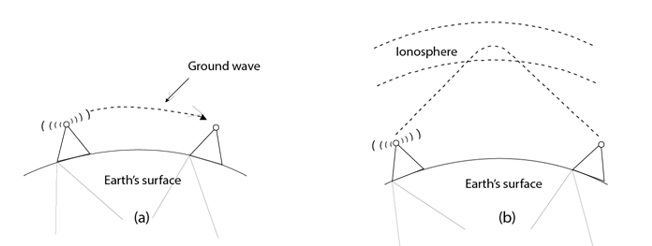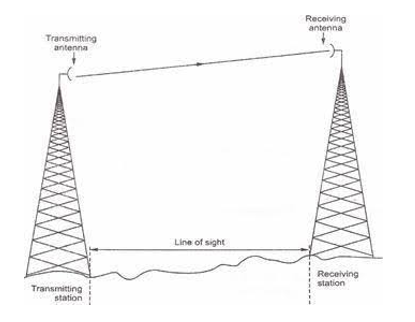Home »
Computer Network
Unguided Transmission Media in Computer Network
Computer Network | Unguided Transmission Media: In this tutorial, we will learn about the categories of unguided transmission media, applications, advantages, and disadvantage.
Submitted by Monika Jha, on November 29, 2019
Transmission media can be categorized in two ways,
- Guided Transmission Media
- Unguided Transmission Media
Here, we are discussing about the unguided transmission media.
Unguided Transmission Media
Unguided Transmission Media is also called wireless communication or unbounded transmission, they transmit electromagnetic waves without using a physical conductor. In this medium signals are radiated through the air (or, in a few cases, water) and therefore, are reaching to anyone with a device capable of accepting them.
Types of Unguided Transmission Media
The following are the types of Unguided Transmission Media:
- Radio waves
- Micro waves
- Infrared waves
1. Radio Waves
Radio waves are electromagnetic waves and are omnidirectional. When an antenna transports radio waves they are propagated in all directions in free space which means the sending and receiving antennas do not have to be aligned that is any receiving antenna can receive that transmitted wave.
The frequency of radio waves about 30 hertz (Hz) to 300 gigahertz (GHz) and like all other electromagnetic waves radio waves travel at the speed of light in vacuum.
Applications of Radio waves
- These waves are omnidirectional so they are useful for multicasting in which one sender but many receivers.
- Examples of radio waves are television, AM and FM radio, cordless phones, and paging.
Advantages and Disadvantages of Radio waves
- Radio waves are easy to generate and penetrate buildings also can travel long distances.
- Radio waves cover a large area and can penetrate the buildings. By this, an AM radio can receive signals inside a building.
- This can also be disadvantageous because we cannot isolate a communication just inside or outside a building. Cause of this, governments strictly legislate the use of radio transmitters.

2. Micro Waves
Micro Waves includes a line of sight transmission that is the sending and receiving antennas that need to be properly aligned with each other. The distance is directly proportional to the height of the antenna which is covered by the signal. In mobile phone communication and television distribution, these are majorly used.
Applications of Micro Waves
Due to the unidirectional properties of Micro Waves, they are very useful when unicast (one-to-one) communication is needed between the sender and the receiver. Cellular phones, satellite networks, and wireless LANs are using Micro Waves.

Microwave Transmission
Types of Microwave Transmission
Two types of Microwave Transmission are as follows,
- Terrestrial Microwave
- Satellite Microwave
1. Terrestrial Microwave
The frequency of Electromagnetic waves between 300 MHz and 300 GHz are called microwaves. These waves are unidirectional. Whenever through an antenna microwave are transmitting, they can be narrowly focused. That is the sending and receiving antennas need to be aligned.
Characteristics of microwaves
- It is inexpensive for short distance expensive as it requires a higher tower for a longer distance.
- Due to environmental conditions and antenna size attenuation (loss of signal) occurs.
- There is a capacity in very high-frequency microwaves that they cannot penetrate walls. This characteristic can be a disadvantage of microwaves if the receiver is inside the buildings.
Advantages
- Microwave transmission is cheaper than using cables.
- It does not require any land for the installation of cables that is free from land acquisition.
- Microwave transmission provides easy communication.
Disadvantages
- Bandwidth is limited in microwave transmission.
- A signal can be moved out of phase and any environmental change such as rain, wind can distort the signal so these signals are susceptible to weather conditions.
- Cause of eavesdropping insecure communication occurs in which any user can catch the signal in the air by using its antenna.
2. Satellite Microwave
A satellite is an entity that revolves around the earth at a certain height. Satellite communication offers more flexibility than fiber optic and cable systems. We can transmit signals from any point on the globe by using satellite transmission.
How does a Satellite work?
The satellite receives the signal that is transmitted from the earth station, and it amplifies these signals. It is retransmitted the amplified signal to another earth station.
Satellite transmission is much like the line-of-sight transmission in which one of the stations is a satellite orbiting the earth. The principle is the same as the terrestrial microwave. Signals still travel in straight lines in satellite transmission.
Features of Satellite Microwave
- It provides transmission capability to and from any location on earth.
- Deployment of Satellite microwaves for orbiting satellites is difficult.
Advantages of Satellite Microwave
- High-quality communication available to undeveloped parts of the world without requiring a huge investment in the ground-based infrastructure.
- It is used in a variety of applications such as radio/TV signal broadcasting, weather forecasting, radio/TV signal broadcasting, mobile communication and mobile, and wireless communication applications.
- The coverage area of a terrestrial microwave is less than the terrestrial microwave.
Disadvantages of Satellite Microwave
- The manufacturing cost is very high of satellite and very expensive to launch a satellite.
- Transmission can go down in bad weather.
3. Infrared Waves
The frequency of Infrared waves is about 300 GHz to 430 THz, which can be used for short-range communication. Infrared waves of high frequencies cannot penetrate walls. This characteristic of Infrared waves prevents interference between one system and another. This means a short-range communication system in a room cannot be affected by another system in the adjacent room.
If we are using the infrared remote control, we do not interfere with the use of the remote by our neighbors. However, by this characteristic, infrared signals become useless for long-range communication. Also, we cannot use infrared waves outside a building because the sun's rays contain infrared waves that can interfere with communication.
Characteristics of infrared waves
- This type of wide bandwidth can be used to transmit digital data with a very high data rate.
- The Infrared Data Association (IrDA) has established standards for using these signals for communication between devices such as keyboards, mouse, PCs, and printers and it is also responsible for sponsoring the use of infrared waves.
- This type of communication provides better security with minimum interference.
References
Advertisement
Advertisement